

Piston rings are manufactured and classified on the basis of function and usability. The primary usage of the piston ring is to seal the chamber (where the piston is moving), which can be a combustion chamber of a 2 stroke or a 4 stroke engine. Marine engines have three or more types of rings fitted on the circumference of the piston.
The piston ring is an essential piston part, and its numbers and functionality differ depending on the type and capacity of the engine.
In 2-stroke large engines, compression type piston rings are used to seal the combustion chamber and wiper rings are installed below them to wipe the deposits from the liner and distribute oil on the liner surface.
Related Read: Reasons for Cylinder Liner Wear and Ways to Measure it
However, in smaller marine engines, different types of piston rings are used for dedicated purposes. E.g. oil scraper ring is used in 4 stroke engine as it’s a trunk type engine, and the crankcase oil has direct access to cylinder liner and piston. In this article, we will have a look at the different types of piston rings used in marine engines.
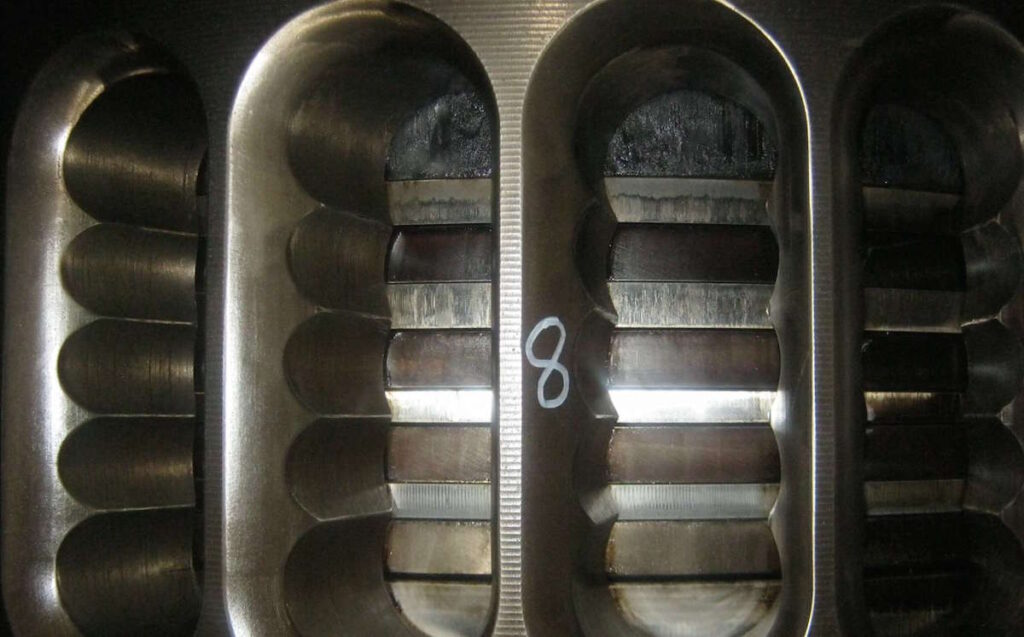

The compression rings provide sealing above the piston and prevent the gas leakage from the combustion side. The compression rings are located in the first grooves of the piston.
However, this may differ according to the design of the engine. The primary function of these rings is to seal the combustion gases and transfer heat from the piston to the piston walls.
The oil is controlled by shearing the layer of the oil left by oil ring, thus providing the top compression rings enough lubrication. Moreover, it also provides help to the top compression ring in sealing and heat transfer.
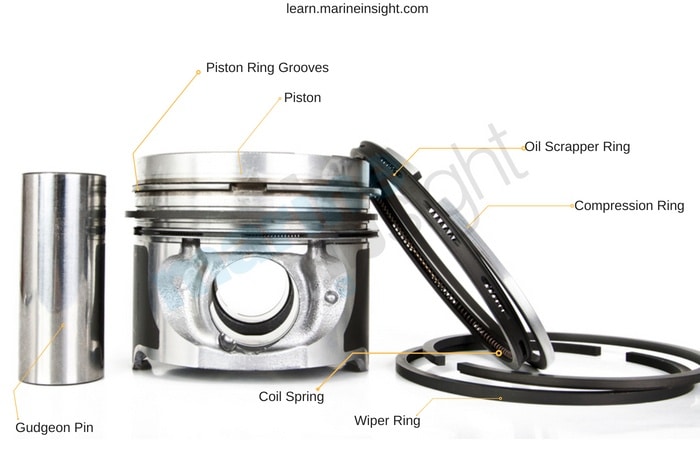

The wiper ring also called a Napier ring, or backup compression ring, are installed below the compression ring. Their main function is to clean the liner surface off the excess oil and to act as support back up ring on stopping any gas leakage further down which escaped the top compression ring. Most of the wiper rings have a taper angle face which is positioned toward the bottom to provide a wiping action as the piston moves toward the crankshaft.
Related Read: How Internal Forces in Marine Engines Affect Their Operation?
If the wiper ring incorrectly installed with the tapered angle closest to the compression ring, it results in excessive oil consumption. This is caused by the wiper ring wiping excess oil toward the combustion chamber.
The oil control rings control the amount of lubricating oil passing up or down the cylinder walls. These rings are also used to spread the oil evenly around the circumference of the liner.
The oil is splashed onto the cylinder walls. These rings are also called scraper rings as they scrap the oil off the cylinder walls and send back to the crankcase.
These rings do not allow the oil to pass from the space between the face of the ring and the cylinder.
Related Read: Intelligent Cylinder Lubrication for Modern Marine Engines
In the oil ring, holes or slots are cut into the radial centre of the ring which allows the excess oil to flow back to the reservoir.
Oil rings can be one-piece or two pieces. To increase the contact pressure between the ring and the liner surface, the rings can have chamfered edges on either the outer sides of the lands or facing the combustion chamber to reduce the oil consumption through improved oil scraping from the bore.
Two-piece oil control rings consist of a cast iron or profiled steel ring and a coil spring which is made from heat-resistant spring steel to act around the whole ring circumference for maintaining the pressure and contact.
One of the most prominent materials used in making piston rings is cast iron. This is because it contains graphite in the lamellar form which itself acts as a lubricant assisting the sliding motion between the rings and the liner.
Alloys and coatings are done on the piston rings, and it will vary as per the type of the ring as the functionality of these rings are different from each other.
The most common form of alloying cast iron is chromium, molybdenum, vanadium, titanium, nickel, and copper.
The piston ring material is kept harder than the cylinder liner to provide maximum life.
Related Read: How are Piston Rings Made?
The combustion chamber of a 2 stroke marine engine is a large space producing an enormous amount of heat and stresses.
The upper rings of the piston are directly in contact with the combustion chamber, hence they need better protection and coating to tackle the thermal stress and provide proper sealing.
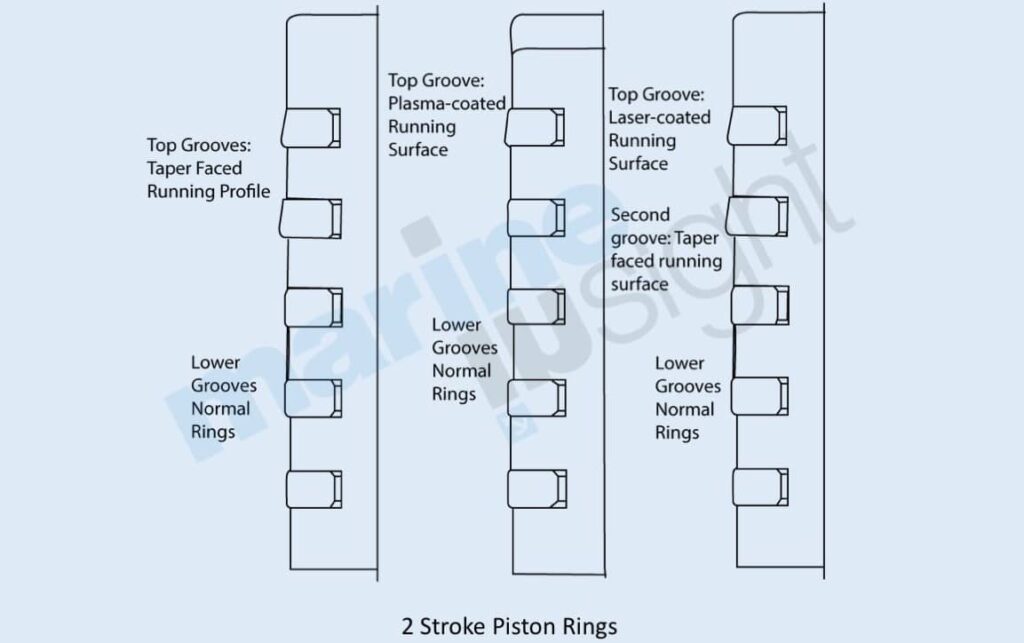

Many new designs were introduced specially for the large two-stroke marine engines. Some of the important design introduced are:
The uppermost piston ring is of Controlled Pressure Relief type in which several oblique shallow grooves (hard chrome plated) are provided on the face allowing some gas pressure to pass through to the 2nd ring thereby reducing the load on the top ring. It has ‘S’ type joint at the ring ends.
A new design was also recently introduced which is a modified version of CPR rings known as CPR Port on Plane rings (CPR POP).
The modification is done on the position of the grooves which are now placed in the lower side of the ring as it was noted that the wear of CPR rings grooves in the running side was faster than usual.
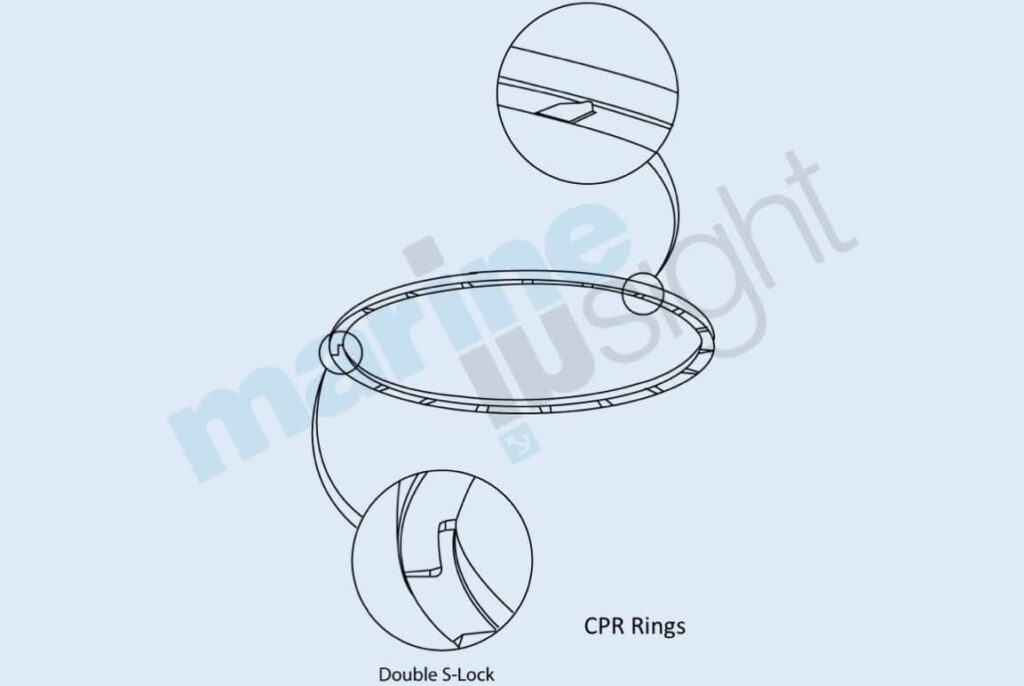

The other rings have an oblique cut at the ring ends. All the piston rings are aluminium-coated on the outer surface for helping in running-in.
In the Wartsila 2 stroke engine, the piston ring grooves on the piston surface are hardened for excellent wear resistance. The top piston ring (also known as Gas Tight (GT) ring in Wartsila) have overlapping ends to avoid gas leakage with an asymmetrical barrel shape. They are chromium- ceramic (CC) coated along with running-in coating (RC).
The number of piston ring will vary depending on the size of the engine. E.g. an RTflex 35 will have a very short skirt and is equipped with three piston rings, but an RTA engine may have 5 piston rings.3
The piston ring requirement in a 4 stroke engine is different as the piston liner assembly is open to the sump. Hence, oil scraper rings are additionally needed in the 4 stroke piston ring-pack. It typically consisting of 2-5 rings depending upon engine type and specification. Usually, 2-4 compression rings are provided to seal the gases from the combustion chamber, and 1-3 oil-control rings are provided to excess avoid oil ingress in the combustion chamber.
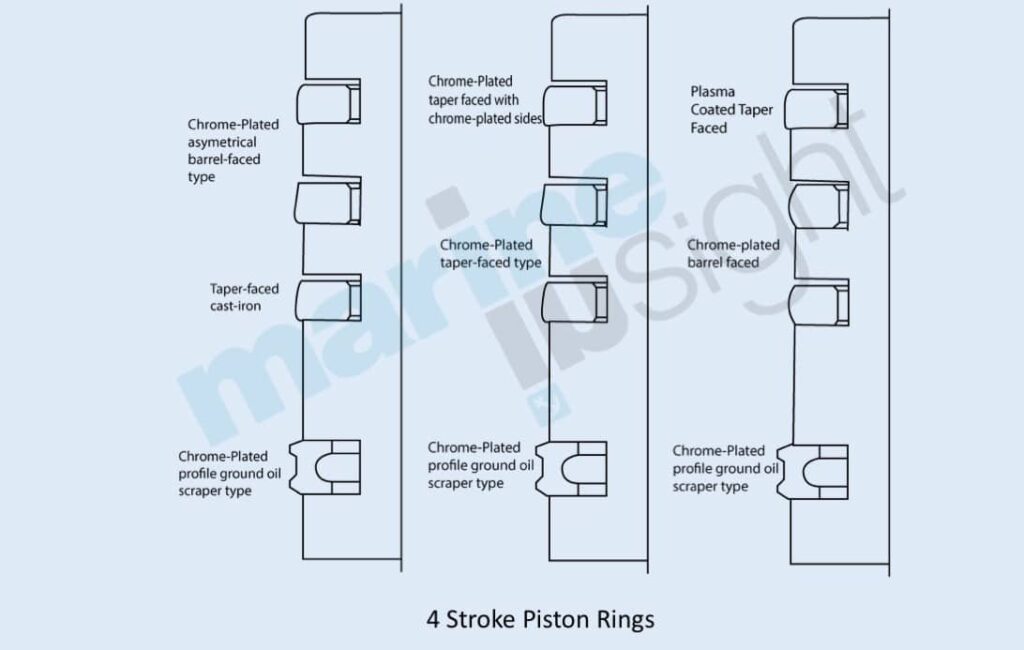

The compressor rings are usually of barrel type with taper face for efficient gas sealing. The oil-control ring profiles comprise two lands and an inserted coil spring to support the pre-tension of the ring.
As explained, there are different types of rings provided in a piston at various levels, which perform different tasks.
The topmost groove of the piston consists of a compression ring whose main function is to seal any kind of leakage inside the combustion chamber during the combustion process.
When the air-fuel mixture is ignited, pressure from combustion gases is applied to the piston head, forcing the piston toward the crankshaft.
The pressurized gases travel through the gap between the cylinder wall and the piston and into the piston ring groove.
During the combustion process, the force of high-pressure gases presses the piston ring against the cylinder liner wall which helps it to form an effective sealing. This pressure pushing the piston ring is proportional to the combustion gas pressure.
The next set of rings in the piston which are placed below the compression ring and above the oil rings are called wiper rings.
They have a tapered face construction and it is used to further seal the combustion chamber. As the name suggests, they assist in wiping the liner wall clean of any excess oil and impurities. If any of the combustion gases were able to pass by the compression ring, these gases will be blocked by the wiper ring in a good condition.
The last set of rings are oil rings which are located at the bottom grooves of the piston closest to the crankcase. The main function of the oil ring is to scrape any excess oil from the walls of the cylinder liner when the piston is in motion.
Majority of the wiped oil is directed into the crankcase back to the oil sump. These oil rings come with spring fitted at the back in a 4 stroke engine to provide an additional push for wiping the liner.
The combustion chamber exerts tremendous pressure on the piston rings. If the combustion pressure of the gas produced inside the chamber is higher than the usual, it may affect the ring performance.
This can be due to detonation and pinging of the fuel from the leaky injector or when the fuel is mixed with dirty air.
Contaminated fuel oil or wrong grade of cylinder oil will also affect the performance of the ring. As the ring starts wearing down, their ability to seal the combustion gases will become apparent.
Bad fuel or cylinder oil quality, bad combustion process, wrong fuel timing, worn liner etc. are the normal cause of piston rings worn out. The most common indication or sign of a worn ring is gas passing into the crankcase or under piston area known as blowby.
Sticky ring due to carbon or sludge deposit and breaking or crack on the ring can result due to wear down.
Inspection of the piston rings is an important task to determine the proper working of piston rings followed by either cleaning or replacing piston rings (if broken or worn out).
In 2-stroke cycle engines, the port containing the top ring usually is at a higher position than the 4- stroke engine’s top ring groove.
During normal scavenge space inspection, the piston rings are pressed with the help of a screwdriver. This is done to check the spring action or tension of the rings. This also tells whether the ring is broken or not. If the ring is broken there will be no spring action.
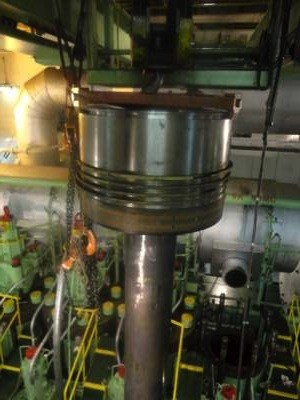

The rings are checked for their freeness in the grooves, as they might get stuck due to carbon deposits and might finally break causing a lot of damage to the liner.
The clearance between the ring and the groove is also checked and the wear is calculated. The ring is checked for scuffing marks and damage, and the overall condition is also assessed.
Related Read: Essential Marine Engine Maintenance Guide For Marine Engineers
During major overhauls, the piston rings are changed completely with the new set. But the following steps need to be considered for scrapping the rings:-
1) If the piston ring is found stuck in the groove.
2) If the axial height of the rings is reduced and the clearance in rings and groove is large.
3) If the chrome layer is peeled off or damaged.
During the overhaul, the grooves have to be properly cleaned off carbon deposits and checked for damage in the ring grooves.


Before putting the piston rings, it should be first rolled rounded in the grooves. In this process, the ring is entirely moved inside the grooves.
With this test, we can check that the grooves are more in-depth than the radial width of the ring.
While inserting the piston with replaced rings in the liner, use the adequately lubricated piston ring compressor tool which will ensure the rings will not stick to the liner face while going inside the combustion chamber.
The piston rings are put inside the worn liner, and the butt gap is also checked. For rings of the small piston (e.g. compressor), the ends can be treated using a piston ring filer, but for marine engines, the rings have to be sent to shore workshop for reconditioning if the butt gap is unusual. While putting rings, they should be checked for markings as to which part is up or down and also check different marking for different positions.
Rings should be put with the help of proper toll, i.e. with the help of ring expander. The clearance between the ring and the groove is checked with the help of the feeler gauge.
The axial and radial clearance of the old ring is checked and recorded to assess the amount of wear for a number of running hours.
Before installing the piston ring, the new or spare ring is checked for its marking and compared with the old one for the same grade or position. If the old piston ring marking is wiped out, check the manual for the identification of the piston ring so that it can be placed in its appropriate groove.
The groove must be cleaned properly to ensure no carbon and sludge deposit are present in it. While cleaning, it is to be kept in mind that some piston grooves are coated with a special protection film. They should not be damaged by the use of a chipping or grinding tool.
Once the groove is properly cleaned, the piston ring is installed using the piston ring tool which expands the ring to be inserted in the groove by sliding it from the top of the piston head. Ensure to insert the ring keeping the top marking on the upper side.
Most of the piston rings are provided with marking “TOP” or the identification number stamped surface is considered as the top face if no specific marking is present.
It is extremely important to use the ring expander tool appropriately as wrong use may damage the ring or it may hurt the operator as the ring is under constant tension.
In small 4 stroke engines, in case the tool is not available, the ring can be expanded by use of clothes or rags available in the engine room.
Two rags are placed on each side of the ring ends and they are pulled so that rings can be expanded and inserted from the top of the piston.
After fitting all the piston rings, ensure the opening or the butt end of all piston rings are not aligned to avoid gas leakage from the chamber.
Similar to all the other machinery parts, the piston ring will also have a set time period of overhaul and replacement. The life of a piston ring entirely depends on the piston ring type, the size of the engine it is fitted on, and the operational condition of the ring and the liner.
For a large two-stroke piston ring with a bore of approximately 900mm, the overall life of the ring can be up to 24,000 hours and for smaller engines of 500mm bore, it can be up to 16,000 hours.
For auxiliary marine 4 stroke engines having high speed, the piston ring life is usually lesser than the 2 stroke engine. The average lifespan of a marine 4 stroke high-speed engine is approximately 8000 hours, post which renewal is required.
You might also like to read:
Disclaimer: The authors’ views expressed in this article do not necessarily reflect the views of The Marine Learners. Data and charts, if used, in the article have been sourced from available information and have not been authenticated by any statutory authority. The author and The Marine Learners do not claim it to be accurate nor accept any responsibility for the same. The views constitute only the opinions and do not constitute any guidelines or recommendation on any course of action to be followed by the reader.
The article or images cannot be reproduced, copied, shared or used in any form without the permission of the author and The Marine Learners.










We believe that knowledge is power, and we’re committed to empowering our readers with the information and resources they need to succeed in the merchant navy industry.
Whether you’re looking for advice on career planning, news and analysis, or just want to connect with other aspiring merchant navy applicants, The Marine Learners is the place to be.